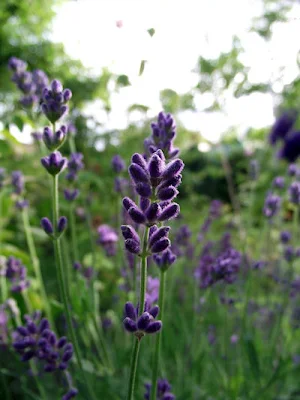Understand the Different Types of Lavender

 |
| English Lavender |
Lavender is enormously popular, but not all lavender is created equal. Using different varieties of lavender will yield different results, and knowing the right lavender for your garden or intended use will help your project be more successful. Lavender flowers can be large or small, and lightly shaded or vivid, depending on the variety you choose. There are even lavender flowers that are white, pink or yellow.
Lavender Varieties
- Lavender likes a sunny, open location in which to grow, and thrives on well drained soil. It is drought tolerant, and naturally pest resistant.
- English Lavender (Lavendula angustifolia)
English lavender is the most popular lavender grown today, and has the bouquet and appearance you probably associate with this classic herb. It has a strong scent, and its fragrance is used for medicinal and cosmetic purposes. It is a common base for aromatherapy oil, and with Lavandula x intermedias, is the variety of lavender most often selected for culinary applications.
English lavender is a hardy perennial from zones 5 – 11 with medium purple flowers, and typically attains a height of two to three feet. It is the variety you should choose if you are planning on using lavender for culinary or craft projects.
A number of the newer English lavenders are smaller in size, with a mounding habit that makes them good edging plants. Varieties that make good multiple groupings would include:
Melissa (pink flowers),
Baby Blue (purple flowers),
French Lavender (L dententa)
Nana Alba (white flowers), and
Martha Roderick (blue/lavender flowers). - French Lavender (L. dententa)
French lavender is not particularly fragrant. Largely used for decorative purposes, its blooms are a less vivid violet in color. *It has serrated leaves, grows to a height of three feet, and is a perennial in zones 8 - 11. The plant most associated with "French lavender" is actually the Mediterranean or Spanish variety discussed below.- Spanish Lavender (L. stoechus)
Spanish lavender has a distinctive deep purple flower with a pinecone shape and upright flower petals. It is native to the Mediterranean and northern Africa, and is a good choice for humid climates.
Typically growing from 18" to two feet, and a perennial in zones 8 to 11, Spanish lavender gives very good spring color, and is a favorite of bees. After flowering, it gets leggy, so trim it back. This isn't a good culinary lavender, but it is very attractive in the garden, particularly when planted out with marigolds.
- Specialty or Unusual Lavenders

Spanish Lavender
Lavender cultivars based on the three varieties described above sport different colors and leaf shapes. There are dozens of them if not more. The most popular lavenders have silver-green foliage with sharp, spear shaped leaves and vivid lavender to purple flowers, although pink, white, blue, and yellow flowering varieties are not uncommon.
*There is a great deal of confusion in the literature regarding which species is actually French lavender. Some experts maintain that it's L. dententa, easily distinguished by it's "toothed" leaves. Others, including Wikipedia, take a broader approach and group L. dententa and L. stoechus both as French lavender. When you shop, pay attention to the scientific name of the plant you have in mind. It will give you an idea of it's origins, habit and environmental preferences.
--------
Photo1 - EnglishLavenderWiki.jpg By Rillke (Own work) [GFDL (http://www.gnu.org/copyleft/fdl.html) or CC-BY-SA-3.0-2.5-2.0-1.0 (http://creativecommons.org/licenses/by-sa/3.0)], via Wikimedia Commons http://upload.wikimedia.org/wikipedia/commons/4/4b/Lavendula.jpg http://commons.wikimedia.org/wiki/File%3ALavendula.jpg
Photo 2 - SpanishLavender1Wiki.jpg By Jean-Pol GRANDMONT (Own work) [CC-BY-SA-3.0 (http://creativecommons.org/licenses/by-sa/3.0), GFDL (http://www.gnu.org/copyleft/fdl.html) or CC-BY-3.0 (http://creativecommons.org/licenses/by/3.0)], via Wikimedia Commons http://upload.wikimedia.org/wikipedia/commons/b/bc/Lavandula_stoechas_JPG1b.jpg http://commons.wikimedia.org/wiki/File%3ALavandula_stoechas_JPG1b.jpg

I'm very curious about the munstead and hidcote varieties. Could you include hardy lavender varieties in the list...?
ReplyDeleteThe Herb Gardener will be able to answer this better, but as I was passing through I thought I'd list a lavender. For me in zone 7, 'Provence' seems to do especially well. I'm not too sure about further north, south or west, but for us in the transition zone, 'Provence' holds its own.
ReplyDeleteThanks, Amanda.
DeleteI have the smaller varieties (Hidcote, Munstead) but my main lavender planting is Grosso. I love the tall sturdy size and the large flowerheads that contain more pungent oil. I'm most interested in growing lavender for use in cosmetics and handcrafts, like hotpads filled with rice and dried lavender buds. I'd appreciate suggestions of other plants hardy in Zone 5 that would suit my uses- THANKS!!
ReplyDeleteYour plants may do just find once they're planted out. Consider asking the nursery where your bought them for additional information, or contact the grower. Information in or on the plant pots may provide you with basic growing tips as well as the name of the grower or distributor.
ReplyDeleteGood luck.
How many different types of lavender is there
ReplyDeleteSome plant experts claim there are over 200 different lavender varieties available, but every year sees new cultivars popping up.
Delete